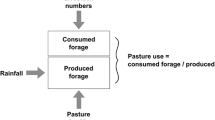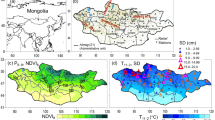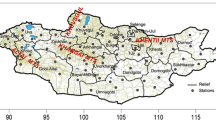Abstract
Extreme weather events represent a large risk to food production systems. In this study, we evaluated the impacts of the 2011–2012 drought in Mexico, the worst in the last 70 years, on free-ranged livestock populations to link extreme weather events and production. We also considered the potential prevalence of recurring droughts under two contrasting future climate scenarios to examine what could happen over this century. Our results showed that cattle and goat stocks decreased about 3% in response to the drought countrywide. Regionally, the changes in cattle and goat populations generally mimicked the precipitation anomaly, with the strongest reductions across the driest areas in central and northern Mexico. Our work showed that the biophysical and management components of livestock production interact depending on the regions and the type of livestock, leading to a mosaic of spatial responses. It seems that the management of large herds limits the economic viability of drought crisis management options such as the importation of fodder and water, or by moving the animals to other pastures. Sheep herds were much less affected since more than 50% of the total sheep stock is raised in wetter states, which showed a relatively small (~ − 10%) precipitation anomaly during the drought. Under the severe climate change scenario, a greater frequency of extremely dry years (once every 3 years) would have negative impacts on livestock production regionally. Climate change together with already existing trends in overgrazing and soil erosion could further increase the sensitivity of livestock production across the country.

Graphical abstract



Similar content being viewed by others
References
Avendaño-Reyes L, Hernández-Rivera JA, Álvarez-Valenzuela FD, Macías-Cruz U, Díaz-Molina R, Correa-Calderón A, Robinson PH, Fadel JG (2012) Physiological and productive responses of multiparous lactating Holstein cows exposed to short-term cooling during severe summer conditions in an arid region of Mexico. Int J Biometeorol 56:993–999. https://doi.org/10.1007/s00484-011-0510-x
Barbier B, Yacouba H, Karambiri H, Zoromé M, Somé B (2009) Human vulnerability to climate variability in the Sahel: farmers’ adaptation strategies in northern Burkina Faso. Environ Manag 43:790–803. https://doi.org/10.1007/s00267-008-9237-9
Brown-Brandl TM, Eigenberg RA, Hahn GL, Nienaber JA, Mader TL, Spiers DE, Parkhurst AM (2005) Analyses of thermoregulatory responses of feeder cattle exposed to simulated heat waves. Int J Biometeorol 49:285–296. https://doi.org/10.1007/s00484-004-0250-2
Buechler S (2009) Gender, water, and climate change in Sonora, Mexico: implications for policies and programmes on agricultural income-generation. Gend Dev 17:51–66. https://doi.org/10.1080/13552070802696912
Buller RE, X., E.H, Gonzalez MH (1960) Grassland and livestock regions of Mexico. J Range Manag 13:1–6. https://doi.org/10.2307/3894888
Campbell DJ (1984) Response to drought among farmers and herders in southern Kajiado District, Kenya. Hum Ecol 12:35–64. https://doi.org/10.1007/BF01531283
Coppock D, Ellis J, Swift D (1986) Seasonal nutritional characteristics of livestock diets in a nomadic pastoral ecosystem. J Appl Ecol 23:585–596
Dieguez Cameroni F, Fort H (2017) Towards scientifically based management of extensive livestock farming in terms of ecological predator-prey modeling. Agric Syst 153:127–137
Easterling W, Apps M (2005) Assessing the consequences of climate change for food and forest resources: a view from the IPCC. In: Increasing climate variability and change. Springer, Dordrecht, pp 165–189. https://doi.org/10.1007/1-4020-4166-7_8
Easterling WE (2007) Climate change and the adequacy of food and timber in the 21st century. Proc Natl Acad Sci 104:19679–19679. https://doi.org/10.1073/pnas.0710388104
Ellis JE, Swift DM (1988) Stability of African pastoral ecosystems: alternate paradigms and implications for development. J Range Manag 41:450–459
Field CB, Barros VR, Mastrandrea MD, Mach KJ, Abdrabo, Adger WN, Anokhin YA, Anisimov OA, Arent DJ, Barnett J, Burkett VR, Cai R, Chatterjee M, Cohen SJ, Cramer, Dasgupta, P, Davidson DJ, Denton F, Doll P, Dow K, Hijioka Y, Hoegh-Guldberg O (2014) Climate change 2014: impacts, adaptation, and vulnerability. Part a: global and sectoral aspects. Contribution of Working Group II to the Fifth Assessment Report of the Intergovernmental Panel on Climate Change. Cambridge University Press
Guerrero Cruz MM (2010) La caprinocultura en México, una estrategia de desarrollo. Revista Universitaria Digital de Ciencias Sociales 1, http://www.cuautitlan.unam.mx/rudics/ejemplares/0101/art06.html. Accessed 1 March 2018
Harris I, Jones PD, Osborn TJ, Lister DH (2014) Updated high-resolution grids of monthly climatic observations—the CRU TS3.10 dataset. Int J Climatol 34:623–642. https://doi.org/10.1002/joc.3711
Heisler-White JL, Blair JM, Kelly EF, Harmoney K, Knapp AK (2009) Contingent productivity responses to more extreme rainfall regimes across a grassland biome. Glob Change Biol 15:2894–2904. https://doi.org/10.1111/j.1365-2486.2009.01961.x
Huber-Sannwald E, Maestre FT, Herrick JE, Reynolds JF (2006) Ecohydrological feedbacks and linkages associated with land degradation: a case study from Mexico. Hydrol Process 20:3395–3411. https://doi.org/10.1002/hyp.6337
INEGI (2015) Producción de ganado bovino. Encuesta Nacional Agropecuaria 2014. http://www.inegi.org.mx/est/contenidos/proyectos/encuestas/agropecuarias/ena/ena2014/doc/minimonografia/prodbovena14.pdf. Accessed 1 March 2018
Katz RW, Brown BG (1992) Extreme events in a changing climate: variability is more important than averages. Clim Chang 21:289–302. https://doi.org/10.1007/BF00139728
Li Y, Ji J (2004) Assessment of the productivity and livestock carrying capacity of Inner Mongolia grassland by regional scale modeling. J Nat Resour 19:610–616
Lobell DB, Bänziger M, Magorokosho C, Vivek B (2011) Nonlinear heat effects on African maize as evidenced by historical yield trials. Nat Clim Chang 1:42–45. https://doi.org/10.1038/nclimate1043
Maass M, Burgos A (2011) Water dynamics at the ecosystem level in seasonally dry tropical forests, in: Dirzo, R., Young, H.S., Mooney, H.A., Ceballos, G. (Eds.), Seasonally Dry Tropical Forests. Island Press/Center for Resource Economics, pp. 141–156. https://doi.org/10.5822/978-1-61091-021-7_9
Manzano MG, Návar J (2000) Processes of desertification by goats overgrazing in the Tamaulipan thornscrub (matorral) in north-eastern Mexico. J Arid Environ 44:1–17. https://doi.org/10.1006/jare.1999.0577
McKeon GM, Stone GS, Syktus JI, Carter JO, Flood NR, Ahrens DG, Bruget DN, Chilcott CR, Cobon DH, Cowley RA, Crimp SJ, Fraser GW, Howden SM, Johnston PW, Ryan JG, Stokes CJ, Day KA (2009) Climate change impacts on northern Australian rangeland livestock carrying capacity: a review of issues. Rangel J 31:1–29. https://doi.org/10.1071/RJ08068
Mellado M, Romero P, García JE, Véliz FG, Arévalo JR (2010) The effects of ambient temperature and humidity on pregnancy rate in Beefmaster cows in a subtropical environment of Mexico. Livest Sci 131:149–154. https://doi.org/10.1016/j.livsci.2010.03.009
Murray-Tortarolo G, Friedlingstein P, Sitch S, Jaramillo VJ, Murguía-Flores F, Anav A, Liu Y, Arneth A, Arvanitis A, Harper A, Jain A, Kato E, Koven C, Poulter B, Stocker BD, Wiltshire A, Zaehle S, Zeng N (2016) The carbon cycle in Mexico: past, present and future of C stocks and fluxes. Biogeosciences 13:223–238. https://doi.org/10.5194/bg-13-223-2016
Murray-Tortarolo GN, Jaramillo VJ, Larsen J (2018) Food security and climate change: the case of rainfed maize production in Mexico. Agric For Meteorol 253–254:124–131. https://doi.org/10.1016/j.agrformet.2018.02.011
Partida de la Peña JA, Braña Varela D, Jiménez Saveriano H, Ríos Rincón FG & Buendía Rodríguez G (2013) Producción de carne ovina. Libro Técnico No.5, Instituto Nacional de Investigaciones Forestales, Agrícolas y Pecuarias, Querétaro, México ISBN: 978-607-37-0036-8
Orlowsky B, Seneviratne SI (2012) Global changes in extreme events: regional and seasonal dimension. Clim Chang 110:669–696. https://doi.org/10.1007/s10584-011-0122-9
Porter JR, Xie L, Challinor AJ, Cochrane K, Howden SM, Iqbal MM, Lobell DB, Travasso MI, Netra Chhetri NC, Garrett K, Ingram J, Lipper L, McCarthy N, McGrath J, Smith D, Thornton P, Watson J, Ziska L (2014) Food security and food production systems. Cambridge University Press
Romero-Lankao P, et al. (2014) North America. In: Barros, V.R., Field, C.B., Dokken, D.J., Mastrandrea, M.D., Mach, K.J., Bilir, T.E., Chatterjee, M., Ebi, K.L. and Estrada, R.C.G.Y.O., Girma, B., Kissel, E.S., Levy, A.N., MacCracken, S., Mastrandrea, P.R. and White, L.L., Eds., Climate change 2014: impacts, adaptation, and vulnerability. Part B: regional aspects. Contribution of Working Group II to the Fifth Assessment Report of the Intergovernmental Panel on Climate Change, Cambridge University Press, Cambridge
Rötter R, van de Geijn S (1999) Clim Chang 43:651. https://doi.org/10.1023/A:1005541132734
Rubio Lozano M. de la S, Braña Varela D, Méndez Medina RD & Delgado Suárez E (2013) Sistemas de producción y calidad de carne bovina. Folleto Técnico 28, Instituto Nacional de Investigaciones Forestales, Agrícolas y Pecuarias, Querétaro, México. ISBN: 978–607–37-0095-5
Sautier M, Martin-Clouaire R, Faivre R et al (2013) Clim Chang 120:341. https://doi.org/10.1007/s10584-013-0808-2
Saville DG (1981) Management and feeding of grazing animals during drought. In: Morley FHW (ed) Grazing Animals. Elsevier Scientific Publishing Co., Amsterdam, pp 335–348
Seager R, Goddard L, Nakamura J, Henderson N, Lee DE (2013) Dynamical causes of the 2010/11 Texas–northern Mexico drought. J Hydrometeorol 15:39–68. https://doi.org/10.1175/JHM-D-13-024.1
SEMARNAT (2017) Secretaria de Medio Ambiente y Recursos Naturales. http://apps1.semarnat.gob.mx/dgeia/informe_resumen/03_suelos/cap3.html. Accessed 1 March 2018
SIAP (2017) Servicio de Informacion Agroalimentaria y Pesquera. https://www.gob.mx/siap. Accessed 13 Nov 2018
Spain JN, Spiers DE (1996) Effects of supplemental shade on thermoregulatory response of calves to heat challenge in a hutch environment. J Dairy Sci 79:639–646. https://doi.org/10.3168/jds.S0022-0302(96)76409-3
Taylor KE, Stouffer RJ, Meehl GA (2011) An overview of CMIP5 and the experiment design. Bull Am Meteorol Soc 93:485–498. https://doi.org/10.1175/BAMS-D-11-00094.1
Vitali A, Felici A, Esposito S, Bernabucci U, Bertocchi L, Maresca C, Nardone A, Lacetera N (2015) The effect of heat waves on dairy cow mortality. J Dairy Sci 98:4572–4579. https://doi.org/10.3168/jds.2015-9331
Zhang J, Zhang L, Liu W, Qi Y, Wo X (2014) Livestock-carrying capacity and overgrazing status of alpine grassland in the Three-River Headwaters region, China. J Geogr Sci 24:303–312. https://doi.org/10.1007/s11442-014-1089-z
Acknowledgements
We thank the Servicio de Información Agroalimentaria y Pesquera, SAGARPA, México, for data on national and state-level livestock populations, as well as the Climate Research Centre, UK, and the CMIP5 modeling groups for the climatic data. GNMT thanks the Universidad Nacional Autónoma de México for postdoctoral funding, during which part of this research was conducted.
Author information
Authors and Affiliations
Corresponding author
Ethics declarations
Conflict of interest
The authors declare no conflict of interest.
Additional information
Publisher’s Note
Springer Nature remains neutral with regard to jurisdictional claims in published maps and institutional affiliations.
Highlights
• The impacts of the 2011 drought on Mexican free-range livestock were studied.
• The biophysical and management components interact to create a mosaic of risk.
• Livestock in arid regions with large herds suffered the sharpest population decline.
• It took 2 years for cattle populations to recover after the extreme event.
• To date, goat populations have not reached the previous stock size.
• Sheep were least affected by the drought.
Electronic supplementary material
ESM 1
(DOCX 1304 kb)
Rights and permissions
About this article
Cite this article
Murray-Tortarolo, G.N., Jaramillo, V.J. The impact of extreme weather events on livestock populations: the case of the 2011 drought in Mexico. Climatic Change 153, 79–89 (2019). https://doi.org/10.1007/s10584-019-02373-1
Received:
Accepted:
Published:
Issue Date:
DOI: https://doi.org/10.1007/s10584-019-02373-1




